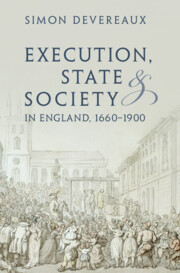Book contents
- Execution, State and Society in England, 1660–1900
- Series page
- Execution, State and Society in England, 1660–1900
- Copyright page
- Dedication
- Contents
- Figures
- Images
- Tables
- Acknowledgments
- Abbreviations
- 1 Introduction
- 2 Executions for Treason, 1660–1820
- 3 Changing Cultures of Execution: Religion and Feeling, 1660–1770
- 4 Changing Cultures of Execution: Reason and Reforms, 1770–1808
- 5 The Murder Act: Anatomization, 1752–1832
- 6 The Murder Act: Hanging in Chains, 1660–1834
- 7 The “Bloody Code” Debated, 1808–1821
- 8 The “Bloody Code” Diminished, 1822–1830
- 9 The Vicissitudes of Public Execution, 1830–1900
- 10 Conclusion
- Archival and Digital Sources
- Index
8 - The “Bloody Code” Diminished, 1822–1830
Published online by Cambridge University Press: 12 October 2023
- Execution, State and Society in England, 1660–1900
- Series page
- Execution, State and Society in England, 1660–1900
- Copyright page
- Dedication
- Contents
- Figures
- Images
- Tables
- Acknowledgments
- Abbreviations
- 1 Introduction
- 2 Executions for Treason, 1660–1820
- 3 Changing Cultures of Execution: Religion and Feeling, 1660–1770
- 4 Changing Cultures of Execution: Reason and Reforms, 1770–1808
- 5 The Murder Act: Anatomization, 1752–1832
- 6 The Murder Act: Hanging in Chains, 1660–1834
- 7 The “Bloody Code” Debated, 1808–1821
- 8 The “Bloody Code” Diminished, 1822–1830
- 9 The Vicissitudes of Public Execution, 1830–1900
- 10 Conclusion
- Archival and Digital Sources
- Index
Summary
Recent historians usually see Home Secretary Robert Peel as a committed opponent of real criminal law reforms, content to hang large numbers of people. He did indeed enter office determined to diffuse reform momentum in parliament and succeeded in doing so, but only for a time. In fact, in pursuing the two reforms that William Paley deemed crucial to relinquishing the “Bloody Code” – preventive policing and more deterrent secondary punishments – Peel behaved like someone who believed his concessions might not hold back the tide of urbane public opinion for long. This was also apparent in his alterations to sentencing practices at assizes and his increasingly careful attention to execution levels in London. Even his consolidation measures were of more genuinely humane consequence than is usually recognized. Indeed, so adaptable to urbane opinion did Peel seem to his older, more determinedly conservative colleagues that by 1830 he inspired their distrust.
Keywords
- Type
- Chapter
- Information
- Execution, State and Society in England, 1660–1900 , pp. 284 - 320Publisher: Cambridge University PressPrint publication year: 2023

